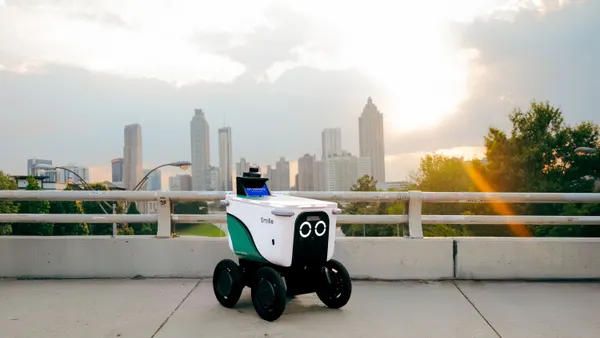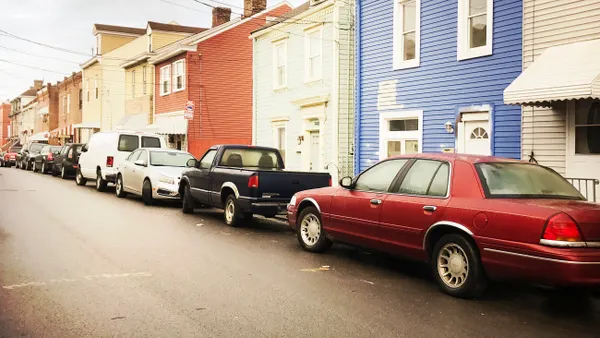In 2014, three female co-founders from the MIT Media Lab and Harvard Graduate School of Design launched Soofa, a tech company focused on bringing smart, citizen-centric and solar-powered infrastructure to cities across the globe. To fill an obvious need of urban citizens — to stay connected and charged — the startup launched the Soofa Bench, a solar-powered phone charging bench equipped with a sensor to detect pedestrian activity.
As time has passed, Soofa’s focus has remained on citizen engagement and forward-thinking innovation — though its product development has evolved the company into a competitive leader in smart infrastructure. In 2016, Soofa unveiled the Soofa Sign, a digital display that acts as a bulletin board for information on public transit, community events and local business offerings.
The Soofa Sign has become a staple for community engagement in Boston, Atlanta and Las Vegas, and the Miami-Dade region will soon welcome Soofa Signs as early as March 2019, thanks to support from Ford’s City of Tomorrow Challenge.
“In true Soofa fashion, we built the software in a way that is fully democratized so that it's not only for cities to communicate with citizens but it really is for everybody to have a dialogue in neighborhoods ... And ultimately that's how it's financed — through the local business advertising dollars,” explained Edward Krafcik, Soofa’s Vice President of City Development.
Smart Cities Dive caught up with Krafcik to learn more about Soofa’s developments in Miami-Dade, its strategies for separating itself from digital kiosk competitors, and the pros and cons of ad-funded infrastructure.
This interview has been edited for clarity and brevity.
SMART CITIES DIVE: How does Soofa Sign differentiate from kiosks like Intersection's LinkNYC, and how do you compete with those companies?
EDWARD KRAFCIK: I think fundamentally what makes us different is the fact that the platform is completely open and we're really leaning pretty strongly into this idea of the digital bulletin board. If you look at all the other kiosks, whether it's LinkNYC or there's a number of advertising companies that are creating a kiosk, at the end of the day it's about providing information to people. The way that we do it is that it's not just pushing information out, but it's really giving everyone an opportunity to respond and create their own information. So that idea of complete openness and democratization of communication is where we really fundamentally differ from a lot of the other kiosk companies.
We are fully solar-powered and wirelessly connected. The unit to install only takes four bolts on the ground — there's no need to excavate the sidewalk, there's no need to run power to it, it's completely sustainable and self-sufficient. So ultimately the unit cost is a fraction of the unit cost of something like a big kiosk, and perhaps more importantly, the time on the costs associated to install it is no more than 30 minutes.
The conversation shifted to equity, which was a topic highlighted in a recent TechCrunch article regarding ad-based infrastructure, referenced in this interview.
We've been able to deploy these in very, very livable neighborhoods, very transformative and emerging neighborhoods ... Then you go just a few miles away and we're in [neighborhoods] where there's a lot in transition, there's a lot of energy but it's not a rich neighborhood. Not a place where maybe you would see some of these bigger kiosks being able to survive because the business model doesn't enable that kind of a system to actually operate in the type of a neighborhood where there's not crazy foot traffic and there's not big brands willing to spend money to be there.
What we're doing is focusing on a deployment strategy that lets us go into all neighborhoods, whether they are very wealthy or they're emerging. So from the city's perspective, they now have a real communication platform that is equitably distributed ... We're not going to throw any competitor under the bus and say our technology is superior, but what is different is the ability to do this in the first place with a sustainable business model because we go into a neighborhood where you'll see people advertising on the sign that run a local business.
How is Soofa utilizing its prize money from the Ford City of Tomorrow Challenge?
KRAFCIK: So that $50,000 will fund the part of the capital and operating costs through for the first year of the signs [in Miami-Dade]. So that helps us with a pretty heavy lift ... We're still a startup so it's a pretty sizable amount of capital to go and deploy new signs.
Ford is helping with that, and they're also a title sponsor ... The sign has not only the electronic paper displays on the digital side but it also has vinyl decals ... Ford, as a title sponsor, ultimately will have their logo on that back vinyl so it's up for a year throughout the pilot, everybody knows that Ford Motors and Ford Smart Mobility is powering this communication platform and that's a strategy actually that's starting to resonate. We've done something similar in Las Vegas with T-Mobile.
We call these kind of larger companies "underwriting sponsors," so it's not that dissimilar to a bike-share where someone would come in — like Citibank to sponsor Citi Bikes in New York — and they're essentially paying to have their name associated with a very beneficial public service. The only difference for us in the way that we really tell the story to a sponsor like a T-Mobile or a Ford is, instead of the bike-share where you help get people from Point A to Point B, really the goal for the sign is to help them more fully connect once they get to Point B from Point A. And I think for a brand, to be part of a conversation with the neighborhood in a city they care about in a way like this is so much more authentic than just putting a billboard up.
Can you talk me through your data collection process? What type of data is Soofa collecting, how are you protecting it and who are you offering data to?
KRAFCIK: I mentioned the bench had a sensor inside of it. So the sensor is the same sensor that we include in the sign. What this does is it measures pedestrian activity by listening for anyone with a Wi-Fi enabled device that walks by. What we get is a timestamp and an encrypted MAC address associated with the Wi-Fi enabled device.
We take that data and when we deliver it back to, let's say the City of Atlanta or the City of Las Vegas or the City of Boston, and what is returned is basically a very high-level aggregation of a time period, being a time of day split into hours with an estimated number of people that walks by. So what we then deliver is insights into the public realm usage and the public realm levels of activation, so it's quite high level. And it's all anonymized so we don't have any personal identifiable information.
When you look at the privacy policy now on our website — which we've always had, we've just made it a little more prominent — we built this privacy policy almost two years ago when we worked with the Parks Department from New York City, who at that time wanted to buy a bench. ... It had a sensor which didn't seem like a big deal, but it was a very big deal for procurement in New York. They said there's no way the Parks Department would buy a bench with the sensor unless it goes through [the city's] privacy guidelines, which at that time were just a draft. So it was pretty amazing, we actually co-wrote the New York City IoT guidelines with the City of New York Mayor's Office of Tech and Innovation, because they needed a case study to use, which was the parks project.
So there's no personally identifiable information collected. The insights are largely around understanding just how public spaces — whether it's a plaza, it's a sidewalk on a street, it's a park — how they get used, not only the number of people per time period but also the repeat visitation rate. We can look at, over a period of time, how many people are coming back to this particular space and we can look at that as a percentage of total. Then we're also doing things like dwell time to see how long somebody actually stays in a particular location.
What does 'smart city' mean to you, or the company at large?
KRAFCIK: Ever since we started the company, the reason we started with the bench was that it was something that was ubiquitous. It was the need that everybody had which to stay connected by staying charged. I think it is helpful for the public to see a technology and keep on thinking about this term "smart city" and see technologies that manifest that theme as a real product.
From where I sit in particular, so much of my work is with city council members, with mayors, with real estate developers and public private partnerships, where at the end of the day there sort of needs to be this phrase that brings together a group of stakeholders. So in a lot of ways, the idea for us is that "smart city" is that phrase that helps connect a lot of very diverse groups and people to achieve a common theme, which is to improve the citizen experience using technology.
For us, "smart city" goes into being not just smart but really social — and using technology to improve citizen experience therefore means using technology to bring people together to do a lot of what was being done on the internet through social network. Replicating that, but in the real world. Not forgetting that people co-exist in neighborhoods. ... The smart city will use technology in a way that brings people outside of the apartment together in cool programs, cool events, cool neighborhood gatherings. At least how we define it, the smart city is really a sustainable and social city, with "social" being one of the key words.
What are you most excited for moving forward?
KRAFCIK: The phrase "ad-supported city infrastructure" I think is very, very scary ... In some cases, the infrastructure that's being deployed is costly in a way that really can only be recovered and be sustainably funded through large advertising dollars. And there's really no other way around it.
Advertising has become a little bit scary because, what you don't want to have happen as an elected official is put in a kiosk that is supported by advertising — and maybe you have the citizens' best interests in mind, and the kiosks will provide Wi-Fi, the kiosks will provide city services and announcements and dynamic digital wayfinding — but the problem now is, as we're seeing more of these being deployed, a lot of the advertising that needs to be shown to fund those amenities is irrelevant. It's part of a broader DMA strategy for a brand.
And then you have all the citizens saying, "I don't really care this much about these services that are being offered because I don't want to see the advertisements. I'd rather do without the services entirely because the advertising is not relevant to me."
"The idea for us is that 'smart city' is that phrase that helps connect a lot of very diverse groups and people to achieve a common theme, which is to improve the citizen experience using technology."

Edward Krafcik
VP City Development, Soofa
I think what I'm most excited for and, as a company, what we're super excited to see is that there is a path forward where an advertisement-supported amenity like a Soofa Sign or particular community bulletin board can be funded sustainably ... In a way where the city can can get a revenue share, and that money can be reinvested into the public realm.
This is all possible. I think we're seeing a change happen. ... We can work with with larger companies to transform how they're messaging so that it's relevant to the local audience that it's being shown to, so that content is paired with relevant community content that's user generated, that's generated by local businesses, that's generated by neighborhood associations in the city.
So what you end up with is an advertising-funded asset and amenity that feels a little bit more like Instagram where you see companies really being more creative [and] thoughtful because they want to feel like they're natively part of someone's feed. That's what we're starting to see with the advertising-supported model that we have in neighborhoods.











